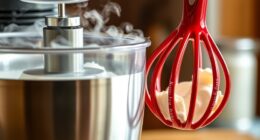Dairy Queen's soft serve isn't classified as real ice cream. It contains only 5% butterfat, while traditional ice cream requires at least 10%. This lower butterfat content means Dairy Queen refers to its treat as reduced-fat ice cream, complying with FDA regulations. Despite this classification issue, many fans still enjoy it for its unique creamy texture and delicious flavors. You might find the soft serve's taste and consistency just as satisfying as traditional ice cream. If you're curious about its intriguing history and other offerings, there's much more to explore!
Key Takeaways
- Dairy Queen's soft serve contains only 5% butterfat, classifying it as reduced-fat ice cream per FDA regulations.
- The FDA defines ice cream as needing at least 10% butterfat and 10% nonfat milk solids.
- Dairy Queen cannot label its soft serve as ice cream due to its lower butterfat content.
- Consumers often prioritize taste and flavor over the technical classification of the product.
- Dairy Queen's unique offerings, like Blizzards and sundaes, are popular despite not being "real" ice cream by FDA standards.
History of Dairy Queen
Dairy Queen's history began on June 22, 1940, when the first restaurant opened its doors in Joliet, Illinois. This marked the start of a journey that would revolutionize the fast-food industry, particularly with its iconic soft serve. The name "Dairy Queen" was coined by Grandpa McCullough, who affectionately referred to soft serve as the "queen" of dairy products, emphasizing its importance on the menu.
With its blend of nostalgic elements and modern appeal, Dairy Queen's offerings have become a favorite among families looking for a sweet treat after a visit to a breathtaking destination.
As time went on, Dairy Queen expanded its reach, opening its first Canadian store in Estevan, Saskatchewan, in 1953 and establishing a global presence. Today, you can find over 6,000 Dairy Queen locations across the U.S., Canada, and in more than 20 other countries. Texas leads the pack with over 600 locations alone.
In 1996, Dairy Queen became a subsidiary of Berkshire Hathaway, Inc., which solidified its financial stability and allowed for continued growth.
The brand's rich history reflects its dedication to serving delicious treats and meals, making it a beloved choice for many. So next time you indulge in a Dairy Queen treat, remember you're part of a global legacy that started with simple soft serve.
What Defines Ice Cream?

When you think about ice cream, you mightn't realize that the FDA has specific requirements, like a minimum of 10% milkfat and nonfat milk solids.
This is where Dairy Queen's soft serve comes into play, as it only contains 5% butterfat and is classified as reduced-fat ice cream.
Understanding these distinctions can help you see why the terms "soft serve" and "ice cream" aren't interchangeable.
Additionally, just as essential oils can enhance mood and promote relaxation, the texture and creaminess of ice cream play a significant role in our enjoyment of this treat, making the experience even more delightful.
FDA Butterfat Requirements
Ice cream lovers often wonder what sets their favorite treat apart from other frozen desserts. The answer lies in the FDA's butterfat requirements. According to the FDA, for a product to be classified as ice cream, it must contain at least 10% butterfat or milkfat, along with a minimum of 10% nonfat milk solids. This regulation guarantees that traditional ice cream has the rich, creamy texture that you expect.
Additionally, understanding the importance of specific dietary choices can help consumers make informed decisions about their treats and overall health, similar to how mammography effectiveness greatly increases survival rates in early breast cancer detection.
Dairy Queen's soft serve, however, contains only 5% butterfat, which doesn't meet the FDA's criteria for ice cream. Because of this low butterfat content, it's categorized as reduced-fat ice cream rather than traditional ice cream. This distinction is important because it reflects the product's formulation and texture.
Dairy Queen uses the term "soft serve" to comply with FDA regulations, differentiating it from standard ice cream. Historically, Dairy Queen's soft serve was even classified as "ice milk" before the FDA eliminated that category.
Soft Serve Characteristics
Defining soft serve involves understanding its unique characteristics that set it apart from traditional ice cream. One major difference is the butterfat content. According to FDA regulations, ice cream must contain at least 10% butterfat, while Dairy Queen's soft serve contains only 5%. This lower fat content classifies it as reduced-fat ice cream.
Another defining feature of soft serve is its texture. Air is incorporated during the freezing process, giving it a creamier and softer consistency than regular ice cream. The serving temperature is also higher, enhancing its unique mouthfeel and pliability. This means when you enjoy a cone from Dairy Queen, you're experiencing that signature softness that's hard to replicate.
Additionally, emulsifiers are utilized in soft serve to stabilize the ingredients, further enhancing the texture. This allows Dairy Queen's soft serve to maintain its shape, which is why their iconic Blizzards stay intact in their cups.
Dairy Queen Classification
Understanding how Dairy Queen's soft serve fits into the broader category of frozen desserts involves looking at what actually defines ice cream. According to FDA regulations, ice cream must contain at least 10% milkfat. In contrast, Dairy Queen's soft serve contains only 5% butterfat, which classifies it as reduced-fat ice cream. Because of this lower butterfat content, Dairy Queen can't legally label its product as ice cream.
Historically, the FDA categorized soft serve as "ice milk," but that classification has since been removed. This change impacts how Dairy Queen markets its products. To comply with FDA guidelines and avoid potential legal issues, the company embraces the term "soft serve."
For over 75 years, Dairy Queen has recognized its soft serve as a distinct product that doesn't meet the legal definition of ice cream. Dairy Queen's website clearly states the absence of the term "ice cream" from its menu, reflecting their commitment to transparency regarding ingredient content and compliance with regulations.
Dairy Queen's Soft Serve Explained

Dairy Queen's soft serve is a unique treat that stands apart from traditional ice cream. With only 5% butterfat content, it falls under the category of reduced-fat ice cream, while traditional ice cream must contain at least 10% milkfat, according to FDA regulations. This lower butterfat level gives Dairy Queen's soft serve its signature creamy texture, enhanced by the incorporation of air during the freezing process, which improves its mouthfeel.
Additionally, Dairy Queen serves its soft serve at a higher temperature than standard ice cream. This distinct serving temperature contributes to its unique characteristics and pliability, making it perfect for cones and sundaes.
The recipe for this beloved soft serve is a closely guarded secret, stored in a safe deposit box, which adds to its allure and distinctive taste.
Since its inception in 1940, Dairy Queen has showcased its long-standing commitment to quality dairy offerings through this iconic soft serve. Each visit to Dairy Queen promises a delightful experience, allowing you to enjoy a treat that's not just ice cream but a deliciously crafted soft serve that stands out in the world of frozen delights.
Popular Treats at Dairy Queen

When you step into a Dairy Queen, you're greeted with a tempting array of treats that go beyond just their famous soft serve. The star of the show is certainly the Blizzard, a delightful mix of soft serve and your choice of toppings. It's one of Dairy Queen's best-selling items and a must-try for any ice cream lover.
Here's a quick look at some popular treats you can enjoy:
| Treat | Description |
|---|---|
| Blizzard | Soft serve blended with your favorite toppings |
| Peanut Butter Bash Sundae | A nostalgic dessert for peanut butter fans |
| Ice Cream Round Cake | Layers of chocolate and vanilla soft serve |
| Deep-Fried Cheese Bites | Crunchy cheese curds served with dipping sauces |
| Caramel MooLatte | A coffee beverage mimicking DQ's frozen drinks |
Whether you're in the mood for decadent desserts or savory snacks, Dairy Queen's menu has something to satisfy your cravings. So next time you visit, treat yourself to one of these delicious options and enjoy the unique flavors Dairy Queen has to offer!
FDA Regulations on Dairy Products

The regulations set by the FDA play an essential role in defining what can be labeled as ice cream. According to FDA regulations, ice cream must contain at least 10% butterfat or milkfat.
Unfortunately for Dairy Queen, its soft serve only contains 5% butterfat, which doesn't meet this standard. The FDA previously classified Dairy Queen's soft serve as "ice milk," but that classification was removed, and now it's categorized as reduced-fat ice cream due to its low butterfat content.
Additionally, the FDA mandates that nonfat milk solids must make up at least 10% of a product for it to be labeled as ice cream. This further separates Dairy Queen's offerings from traditional ice cream, as their soft serve doesn't meet this requirement either.
To comply with these legal obligations and accurately represent their ingredient content, Dairy Queen has embraced the classification of its products as "soft serve."
Understanding these FDA regulations is vital for you to grasp why Dairy Queen's soft serve isn't considered real ice cream by the official standards.
Customer Opinions and Reactions

Many customers simply don't care about Dairy Queen's product classification; they prioritize taste over whether it's labeled as ice cream or soft serve. For many, the creamy texture and delightful flavors are what keep them coming back, regardless of the terminology.
Customer opinions vary, with some expressing curiosity about why Dairy Queen doesn't call its offerings ice cream, especially after a TikTok user pointed out the absence of that term on the menu.
Former Dairy Queen employees have even brought up the historical use of "ice milk," adding another layer to the conversation. Yet, most patrons seem to accept the soft serve for what it is: a delicious treat that satisfies their sweet tooth.
The internet's chaotic nature reflects this mix of confusion and enjoyment, with some fans passionately defending their favorite dessert.
While FDA guidelines may dictate what can be labeled as ice cream, it seems many customers are more focused on flavor than on classification.
The bottom line? Whether you call it soft serve or ice cream, if it tastes good, that's what truly matters to you and fellow Dairy Queen enthusiasts.
Unique Dairy Queen Marketing

With a keen focus on its unique offerings, Dairy Queen cleverly markets its soft serve by emphasizing the term "soft serve" over "ice cream." This strategic choice not only aligns with FDA regulations but also highlights the brand's commitment to delivering a distinct product with a creamy texture that stands out.
By using just 5% butterfat, Dairy Queen cultivates a unique taste that sets its soft serve apart from traditional ice cream, which requires at least 10% milkfat.
Dairy Queen's marketing strategy also shines through its signature Blizzard, promoted with eye-catching visuals and promotions. Serving Blizzards upside down has become a hallmark of the brand, showcasing the thickness and quality of their soft serve while enhancing customer interaction.
This fun presentation encourages customers to engage with the product, making it memorable.
Furthermore, Dairy Queen actively solicits customer feedback through surveys sent to DQ App users. This approach not only fosters customer interaction but also helps shape their offerings based on real consumer insights.
The Secret Soft Serve Recipe

While you may enjoy Dairy Queen's iconic soft serve, few know that its recipe is a closely guarded secret, locked away in a secure deposit box. This top-secret formula is essential to the brand's identity and product uniqueness.
Only a select few individuals have access to the secret recipe, with limited keys distributed to maintain its confidentiality. This careful safeguarding has been a long-standing tradition for Dairy Queen since its inception in 1940.
The distinctive taste of DQ's soft serve contributes greatly to its popularity among customers. As you indulge in that creamy texture and rich flavor, remember that it's more than just a treat; it's a product of meticulous branding efforts.
The secrecy surrounding the recipe isn't just about keeping competitors at bay; it's a cornerstone of Dairy Queen's marketing strategy, ensuring that every cone and sundae delivers the same unforgettable experience.
Fun Facts About Dairy Queen

Dairy Queen's history is filled with intriguing facts that showcase its unique offerings and cultural impact. Did you know that Dairy Queen's soft serve contains only 5% butterfat? This lower butterfat content classifies it as reduced-fat ice cream, while traditional ice cream must have at least 10% butterfat according to FDA regulations.
One of the most iconic features of Dairy Queen is the curl on top of its soft serve. This trademarked design requires skill and practice for employees to master, ensuring each cone is perfectly crafted.
Another fun aspect is the Blizzard, Dairy Queen's signature treat, which is famously served upside down. This quirky policy originated from a customer request back in 1983, and it's become a beloved tradition ever since.
The first Dairy Queen restaurant opened on June 22, 1940, in Joliet, Illinois, and it has grown to over 6,000 locations worldwide.
Beyond delicious treats, Dairy Queen also gives back to the community, supporting initiatives like the Children's Miracle Network through donations and product grants via DQ Cares.
Enjoying a Blizzard or a soft serve cone feels even better knowing you're part of that legacy!
Comparison With Other Ice Cream Brands

When you compare Dairy Queen to other ice cream brands, the difference in butterfat content stands out.
With only 5% butterfat, DQ's soft serve doesn't quite stack up against the 10-16% found in traditional ice creams like Häagen-Dazs or Ben & Jerry's.
Plus, DQ's soft serve is classified as "soft serve," setting it apart from brands that proudly market their products as real ice cream.
Butterfat Content Comparison
Exploring the butterfat content of various ice cream brands reveals significant differences that affect taste and texture. Dairy Queen's soft serve contains only 5% butterfat, categorizing it as reduced-fat ice cream. This doesn't meet the FDA's 10% requirement for traditional ice cream, resulting in a lighter texture and unique mouthfeel.
In contrast, premium brands like Häagen-Dazs and Ben & Jerry's boast higher butterfat levels, typically ranging from 14% to 16%. This richness contributes to their creamy texture and robust flavors. Other brands, like Breyers, offer a variety of butterfat levels, yet their standard products still qualify as traditional ice cream.
Here's a quick comparison of butterfat content across different brands:
| Brand | Butterfat Content |
|---|---|
| Dairy Queen | 5% |
| Häagen-Dazs | 14-16% |
| Ben & Jerry's | 14-16% |
| Breyers (standard) | 10% |
| Breyers (varied) | Varies |
With these variations, it's clear that butterfat content plays an essential role in the overall experience of ice cream, influencing both texture and flavor.
Product Classification Differences
How does Dairy Queen's soft serve stack up against traditional ice cream brands? The main difference lies in the butterfat content. Dairy Queen's soft serve contains only 5% butterfat, while the FDA regulations require a minimum of 10% for a product to be classified as ice cream.
Because of this lower butterfat content, Dairy Queen's offering is classified as reduced-fat ice cream instead of traditional ice cream. This classification sets Dairy Queen apart from brands like Ben & Jerry's or Häagen-Dazs, which use higher butterfat levels and can market their products simply as ice cream without facing the same labeling restrictions.
While Dairy Queen's soft serve is creamy and delicious, it doesn't fit the same category as those higher-fat options. Dairy Queen adheres to FDA guidelines, which influences their marketing strategy. They focus on highlighting the unique taste of their soft serve rather than the technical classification.
Frequently Asked Questions
What Is Dairy Queen Ice Cream Made From?
Dairy Queen's soft serve is made from a blend of milk, sugar, and emulsifiers. With only 5% butterfat, it's classified as reduced-fat ice cream, offering a creamy texture but differing from traditional ice cream.
Is Dairy Queen Ice Cream Real or Fake?
Isn't it interesting how we define our favorite treats? Dairy Queen's soft serve isn't technically ice cream due to its low butterfat content, but that doesn't stop you from enjoying its deliciousness on a hot day!
Is Dairy Queen Ice Cream Healthy?
If you're wondering about Dairy Queen's healthiness, remember moderation's key. While they offer reduced-fat options, frequent high-sugar treats can lead to health issues. Always check nutritional info to make informed choices that suit your diet.
Does Dairy Queen Use Real Ice Cream in Their Milkshakes?
While you might expect a classic milkshake to be made with real ice cream, Dairy Queen's milkshakes use a soft serve that doesn't meet the legal standards for ice cream, creating a unique, lower-fat experience instead.
Conclusion
So, is Dairy Queen's soft serve real ice cream? While it may not meet the traditional definition, it's a beloved treat that many enjoy. With its unique texture and flavor, Dairy Queen has carved out a special place in the hearts of dessert lovers. Plus, the fun and nostalgia of their treats keep customers coming back for more. Whether you call it ice cream or not, it's hard to deny the joy a Blizzard can bring! And if you’re a fan of their soft serve, you’ll be delighted to know that Dairy Queen also offers the beloved blue moon ice cream flavor. With its vibrant hue and fruity taste, it’s the perfect addition to their menu for those looking for a little twist on a classic treat. Whether you’re a soft serve purist or you enjoy experimenting with different flavors, Dairy Queen has something for everyone to enjoy.










